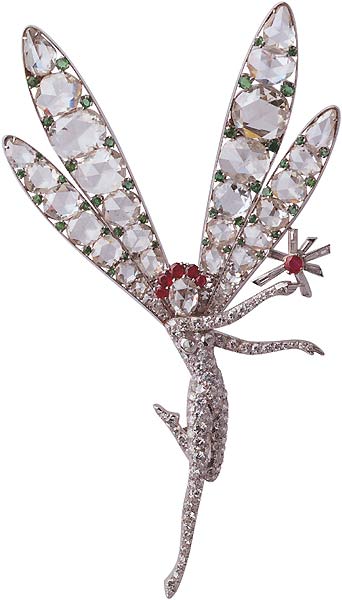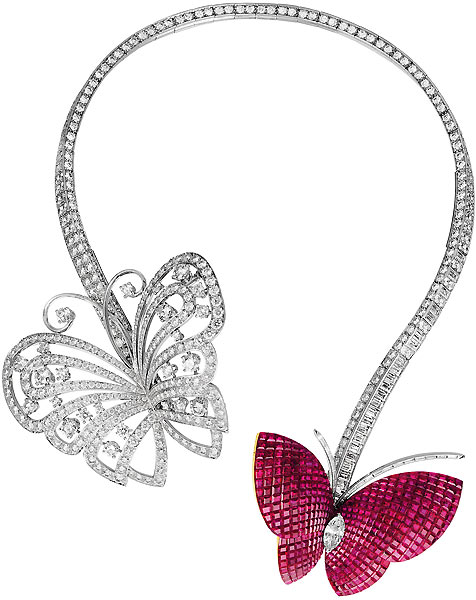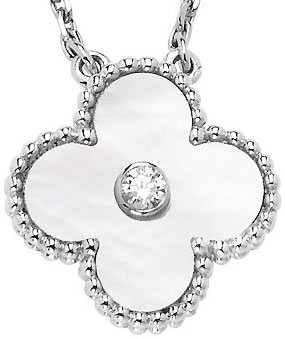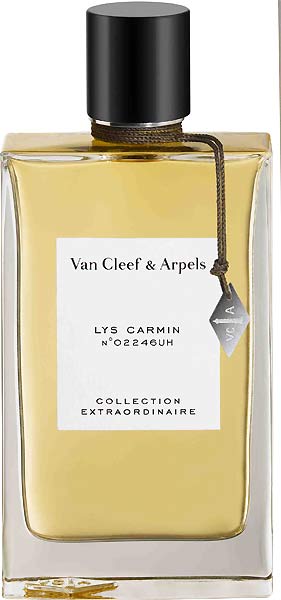
beautyme collections culture cuisine motor music search
 Van Cleef & Arpels
Van Cleef & Arpels
fall 2009
Japanese culture on jewellery and perfume
In fall 2009, the French jewellery house Van Cleef & Arpels presents the fruits of its rich history of style in a special Vintage piece for Christmas 2009, the perfume 'Collection Extraordinaire' designed by leading perfumers of Symrise and Givaudan after the jeweler's garden creations 'Les Jardins', and the exhibition 'The Spirit of Beauty' from 31 October 2009 until 17 January 2010 at the Mori Arts Center Gallery in Tokyo.
The gallery of the Mori Arts Museum in Tokyo's new cultural center, the so-called 'Roppongi Art Triangle, shows approximately 300 jewels, fashion accessories, timepieces and objects d'art from over 100 years of the jewellery house that was founded by the married couple Estelle Arpels and Alfred Van Cleef at 22 Place Vendôme Paris in 1906. Today, Van Cleefs & Arpels has more than 55 boutiques worldwide. The traditional themes of the house include nature, couture and art.
fig.: The exhibition 'The Spirit of Beauty' is named after the Van Cleef & Arpels Fée Libellule (Dragonfly fairy) clip (1944).
Scenographer of the exhibition is the French architect Patrick Jouin who is the interior designer of the historic boutique on place Vendôme. For 'The Spirit of Beauty' at Mori Arts Center, he has created a dreamlike story about four themes: The Spirit of Nature, The Spirit of Elegance, The Spirit of Adventure and Incarnations.
The French jewellery house has a strong connection to Japan such as you can find in the current perfumery line (details below) that is inspired by the garden styles of the world - even the Japanese.
 When the house was founded in 1906, Japanese prints have been in fashion. The Europeans got many new ideas from the Japanese culture of colour and light, line, composition and perspective. Van Cleef & Arpels created pieces like the 'Jardin Japonais' clip (1924) or
the 'Paysage Japonais' (1930), which were inspired by the
iconography of Japan.
When the house was founded in 1906, Japanese prints have been in fashion. The Europeans got many new ideas from the Japanese culture of colour and light, line, composition and perspective. Van Cleef & Arpels created pieces like the 'Jardin Japonais' clip (1924) or
the 'Paysage Japonais' (1930), which were inspired by the
iconography of Japan.
fig.: The “Mystery Setting“ is a revolutionary process developed by Van Cleef & Arpels in the early 1920’s and patented in 1933. It allows the setting of stones without any of the visible metal prongs or nails traditionally used to hold the stone. The jeweller constructs an extremely fine net of gold into which each stone is individually inserted. Perfectly matched and hugging the most complex shapes, the stones come together to form a seamless and precious surface made up of rubies, emeralds, or sapphires.
In 2004, the French Jewellery house asked the Japanese master of lacquer work, Hakose San, to create a series of butterfly clips in letterwood and lacquer. In his Wajima workshop, the renowned artist Hakose San created a collection of unique pieces inspired by the fresh interpretation of traditional decors. Therefore he used an ancestral technique that makes it necessary to involve twenty stages and over a hundred manufacturing procedures.
Since 1973, the French jewellery is available in Japan. More than 20 years later, Van Cleef & Arpels opened the first boutique in 1999 in Tokyo. It was the first French jeweller that opened an own store in Japan. Today, the jeweler can be found in 15 boutiques in Tokyo, Osaka, Kobe, and other major cities. The Alhambra (image below) and Rose de Noël collections are the most beloved in Japan. The Mori Arts Center Gallery publishes an own website for the exhibition thespiritofbeauty-vancleef-arpels.com.

 fig.: The Alhambra Vintage is created after the original design of 1968. The special edition for Christmas 2009 with a pendant in white mother-of-pearl, white gold, and a diamond in the centre will be available from November 2009. The
clover design stands for good luck and eternity.
fig.: The Alhambra Vintage is created after the original design of 1968. The special edition for Christmas 2009 with a pendant in white mother-of-pearl, white gold, and a diamond in the centre will be available from November 2009. The
clover design stands for good luck and eternity.
fig.: Perfume Lys Carmin (Carmine Lily). 02246UH from the 'Collection Extraordinaire', 2009. Composed by Nathalie Cetto/Givaudan. Behind the name of the perfume stands the individual laboratory number - an old tradition of Haute Perfumery.
At the bottom of the bottle you can find the mongram of Van Cleef & Arpels.
The perfume 'Lys Carmin' is described as a proud, majestic scent. Probably, because the scent is warm but radiates a distinctive distance. This impression comes from the extraordinary composition of floral and animally notes. It is such a surprising scent because it opens with an intense bouquet of flowers, full in blossom underlaid with the animally, spicy notes of the carmine red lily. The perfume leaves with warm notes of cinnamon and red pepper.
This is the first Haute Perfumery collection by Van Cleef & Arpels. It was launched in September 2009. Van Cleef & Arpels served with the 'Les Jardins' jewellery collection the inspiration for the 6 different scents. The perfumes are following the impression of Japanese garden art with its meditative arrangements of plants and stones, Italian Renaissance gardens with an antic flair, French geometrical, very structured gardens, and English gardens that surprise with exalted eccentricity. Composers of the 6 scents are Nathalie Feisthauer/Symrise, Randa Hammami/Symrise, Nathalie Cetto/Givaudan, Antoine Maisondieu/Givaudan, Emilie Coppermann/Symrise, Marc Buxton/Symrise.
more culture>>>